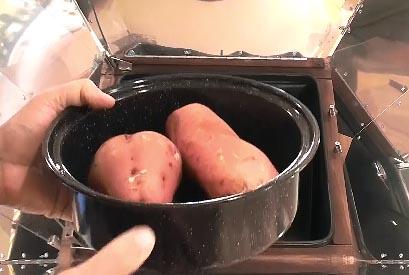All American Sun Oven Review 10+ Years Later
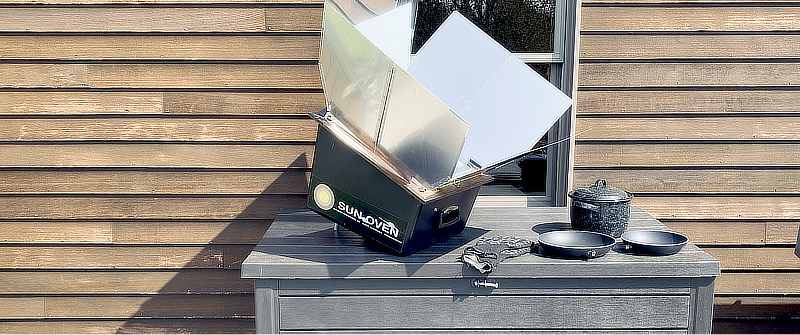
This is about my experience with the All American Sun Oven. I enjoy experimenting with harnessing energy from the sun. I have built several solar cooker ovens over the years, and I also purchased the All American Sun Oven given it’s apparent efficiency and usability. I’ve now had it for so long, that I felt compelled to write a sort of real-world review on it.
My All American Sun Oven is now it’s 15th year of service! And you know what? It still functions like new, despite the nicks and scratches over time.
[ Editors note: I believe my originally published version was sometime during 2008 shortly after I bought it. Then an update in 2018, 10 years later. Now, this latest update is more of an overhaul / review for the All American Sun Oven with additional photos, experiences and information, since I’ve had it for so long (~ 15 years!) ]
All American Sun Oven Review based on my use and opinion
If you are thinking about buying this solar oven, and if I haven’t answered any of your questions or curiosities within the article, leave a comment for me down below and I’ll try to answer your question..
I’ve had the SUN OVEN for many years. First bought it while living in a part of California where the sun shines all summer long. Because of that, we were able to use the All American Sun Oven quite often! And that’s how I justified the purchase.
Which brings me right to the first glaring point about this solar oven.. so lets get it over with first..
Cost
It’s expensive. And because of that, it’s not for everyone who may be interested to find one within their budget. As the model name implies, it is made in America. So there’s that.. However with this product, ‘you get what you pay for’. Yes, it costs a bit more than it should in my opinion. But 15 years later, I don’t regret it, and I’m very glad that I have it. Excellent preparedness item too.
If you’re looking for one of the best and you’ve got the money (as it continues to inflate away anyway?), then go ahead and convert it to this tangible asset.
(view it on amzn) but come back to read more of my review..
How often can you actually use it?
Since I first bought it, and having used it often while living in California, now we live in New Hampshire. It’s not as sunny all the time, comparatively. And we have longer winters too, so it doesn’t get used during that time (though I could on some days, depending on ambient temperature and not in the middle of winter with such a low angle of sun).
Some of you might be wondering how often you can actually use a solar oven when it’s not always sunny. Well, certainly not as much. It obviously depends on the time of year, the weather, wind, and clouds.
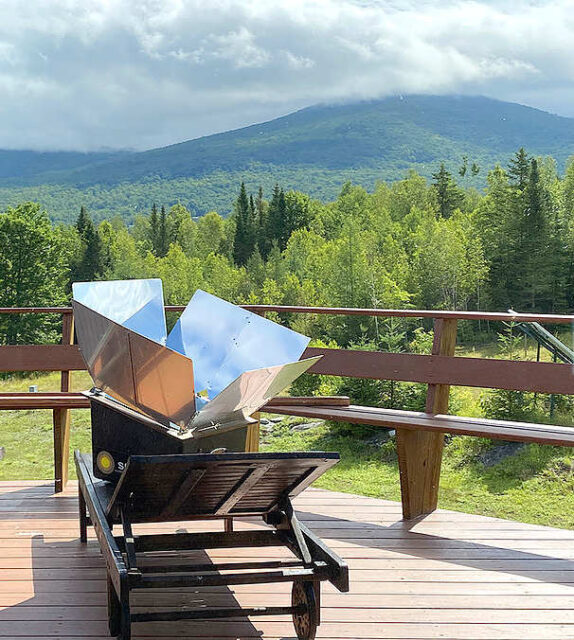
Even on partly cloudy days, you really need a day when there’s more sun than clouds. However, this All American Sun Oven is very efficient and will warm up / heat up nicely when there’s just enough sun. I really cannot define the threshold where it’s not worth the effort trying to cook on a partly cloudy day. It’s something you just sort of figure out on your own.
For me, the All American Sun Oven purchase wasn’t so much about how often I could or would use it. Rather, it was more about feeling good about having a very practical way to heat and cook foods with the sun – for fun, and ‘just-in-case’.. I suppose it was the ‘prepper’ in me. With that said, it does get used a good bit when I’m in the mood :-)
How hot does the All American Sun Oven get?
Incredibly, the SUN OVEN can heat up to temperatures as high as 350 to 400 Degrees Fahrenheit! Yes, you read that right! Now granted, you need the right conditions for that.
Here’s an example.. Since I decided to update this review today, well this morning I set it up for some additional photo opportunities. Around 10 AM, outdoor temperature was around 65 degrees-F, sunny but hazy sky (no clouds), the internal temperature quickly rose to 300 – 325. Not bad!
It was hot enough to sizzle up some of my homegrown bell peppers in olive oil with garlic & herb spices. Hot enough to fry an egg in sizzling butter. I’ll talk about the pots and pans, and cooking tips in a minute..
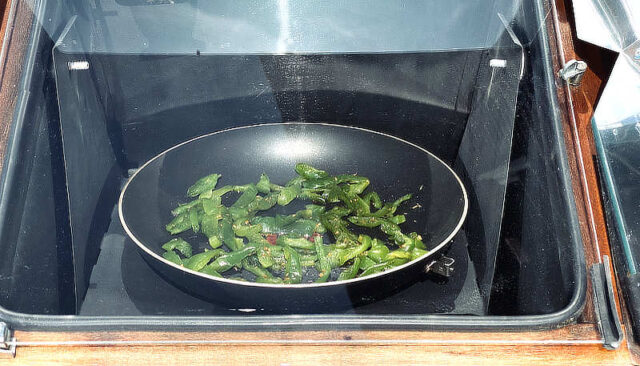
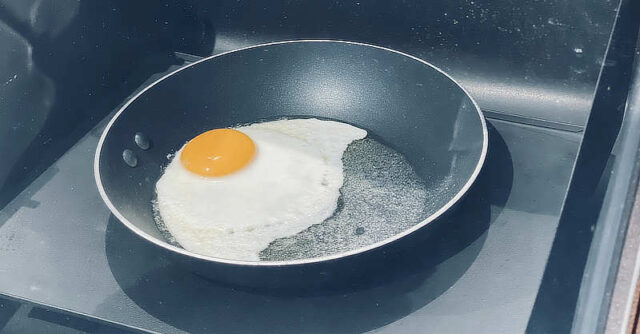
The All American gets hot enough to..
- Bake Foods
- Boil Foods
- Steam Foods
- Boil Water
- Slow Cook
- Hot enough for safe internal cooking temps
I did varnish the wood trim a few times to help preserve that part (that helped a lot, and I advise you do the same when you notice the wood trim beginning to dull).
Why I Bought The All American Sun Oven
So, why did I buy it? Good question! It is expensive (even back when I purchased it). I know I already said that..
I justified the purchase for preparedness sake, coupled with enough days during the year to actually use it. Cooking without electricity (and/or fossil fuels) was appealing. Kind of a self-sufficiency thing…
During years past, I have built several solar cookers too. It was fun to do. Then I bought this one. At the time, it was branded as “SUN OVEN”. Though today it’s called the All American Sun Oven.
- I felt that the SUN OVEN would be good for use at home, anytime on sunny days (weather permitting).
- It could also be good for camping (especially where open fires may not be allowed).
- It will provide a means of cooking during a power outage (particularly useful during a longer term grid-down!).
- A side benefit during summer would be cooking outside (less heat inside the house).
- It’s simply another method of heating and cooking foods, free energy from the sun.
The SUN OVEN has been a reliable and HOT cooker during the many years I’ve had it. My homemade solar cooker does not get as hot, but high temperature doesn’t really matter when it comes to slow cooking most foods.
Made in the USA.
The Ultimate Solar Appliance
(view on amzn)
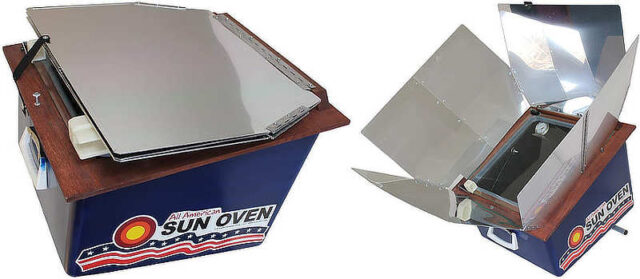
Some of the features in the All American Sun Oven
Well insulated. I don’t know what they’re using for insulation, but I suspect some kind of injected foam? Anyway, it sure seems to be pretty efficient. I’ve never noticed a smell or anything, so that’s good..
The internal tray is called a “spill-proof levelator”. It’s kind of a self leveling tray that hangs from two bolts. You can see it in a photo above showing the pan setting on this tray. It’s simple to take it on and off because of the flex in the tray.
Glass hinged cover / door and gasket. I just love their design here. It’s simple, yet quite user friendly. The glass is pretty thick too. Speaking of the glass door / cover, here’s a tip.. First take a look at the photo below (taken while cooking my peppers this morning).
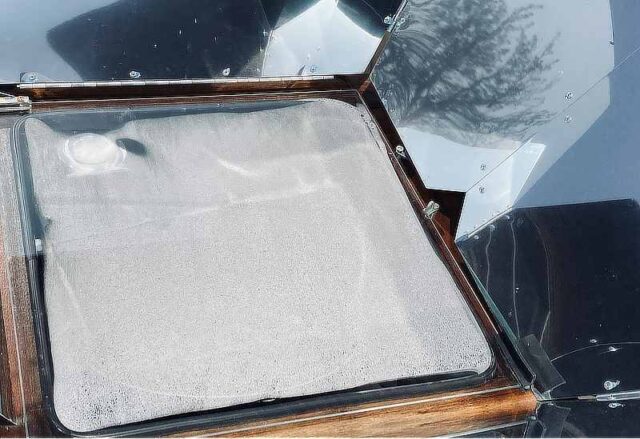
That’s steam on the inside of the glass door. This can happen when cooking on a pan without a cover (sometimes even with a cover). Look about halfway down the right side of the glass door. there’s a little swivel that snugs the glass to the gasket after you close it. If it steams, open the door, wipe the glass with a microfiber cloth (quickly soaks up the liquid). Then close, but don’t latch the thingy (lever). There will be just enough gap to allow it to breathe..
Adjustable tilt. Regardless of angle (it also has a built in adjustable leg for setting the angle towards the sun), the tray inside remains level. Nice feature!! I use the tilt adjustment every time I run this oven – optimized for time of day sun angle, and the angle of sun depending on the season (how high in the sky).
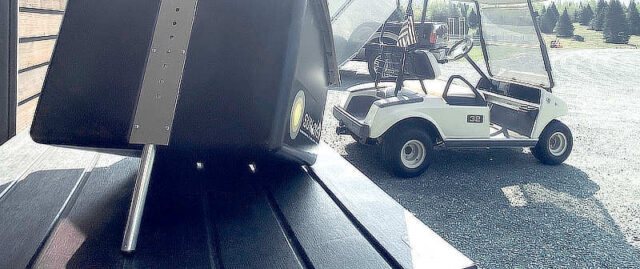
Folding reflector panels. I’ve continued to like how they engineered the reflector panels to easily fold together for storage, or for use. So easy. As you can see in the photo below, the reflector panel hinges have held up well during the 15 years I’ve had this. They’re ordinary rivets, but still holding.
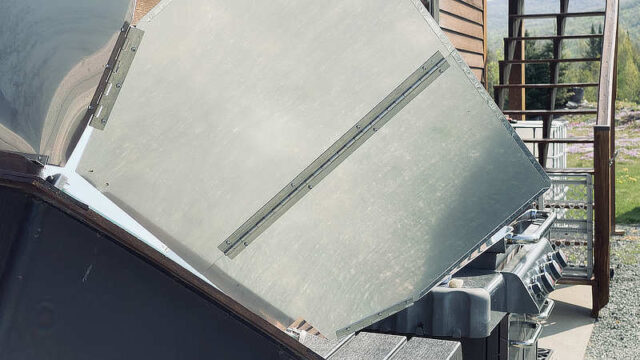
What size pots and pans will fit in the All American Sun Oven
Here’s the reality. Nothing too big. But, big enough for a decent meal.
Black pot with a cover. The 4 quart Granite Ware enamel pot shown below is perfect. It measures 8″ tall (to the top of the cover handle). This leaves maybe 1/2″ to spare before it would contact the glass door (based on the tilt angle shown below). The distance from left to right of the hanging tray itself is 13″.
Granite Ware Enamel on Steel 4-Quart
(amzn)
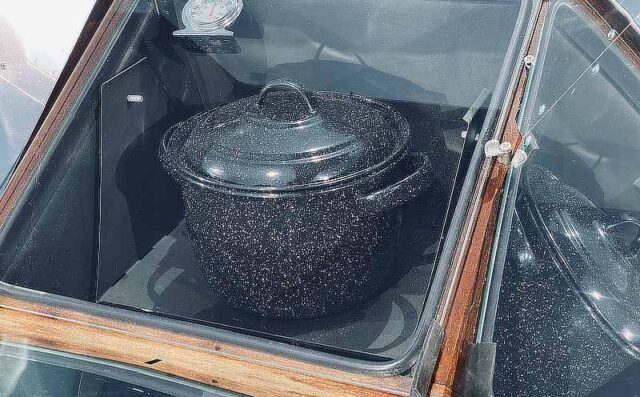
This one will fit too..
Granite Ware Covered Casserole, 5-Quart
Fry pans. Here’s another tip. I had an old set of T-fal nonstick pans (11″, 9.5″, 8″). The handles easily unscrewed so I could use them on the tray in the All American Sun Oven! If you can find a set where you could do the same, that’s a nice thing to have. You can see an example further above where I was cooking the peppers and an egg.
I just looked in my previous orders on amzn. This is the exact set:
T-fal Specialty Nonstick 3 Piece Fry Pan Set
Solar Oven Cooking Temperature Realities
Yes, the SUN OVEN can achieve high cooking temperatures under ideal conditions. By the way, it has a built in Thermometer.
However, I believe that a lot of people have it in their head that food must be cooked at 350 degrees in the oven, because it’s the most referenced temperature in recipe books for oven cooked foods.
But guess what… so long as the internal temperature of most foods and meat is heated to 165 degrees, then it becomes safe to eat.
For example, a solar cooker that maintains 225 degrees for a long enough time, will easily cook the internal temperature of food up to 165 degrees. Of course, the higher the temperature of the solar cooker, the faster your food will reach 165 degrees. That’s one area where the All American Sun Oven excels.
By the way, you really, really need a temperature probe when cooking meats in a solar oven. Confirm a safe internal temperature! For what it’s worth, I have two of these. Really like them..
Instant-Read Digital Meat Thermometer
(amzn)

Here’s a tip. If you’re cooking meat in a solar oven, say, in a covered pot (e.g. chicken and potatoes or whatever..), here’s another way to keep up with the internal temperature. Use a probe. It will easily squish between the glass and gasket.
Dual Probe 2 in 1 Thermometer
(amzn)
When I lived in sunny California, my homemade solar oven cooker had a hard time getting hot enough during the winter months when the sun was lower in the sky, and obviously colder outside. Whereas the All American Sun Oven heated much, much better because it’s more efficient at capturing the sun’s rays and keeping the heat inside (insulation).
For those of you starting out with solar oven cooking, I want to tell you one of the secrets to getting even more deliciousness out of many meals, especially baked potatoes. Okay, here it is… add some water to the pan, and keep the pan covered. Simple! Of course, spice it up to your delight.
Great for baking potatoes. Again, add water into the pan, and cover it. Oh boy, does that taste good!
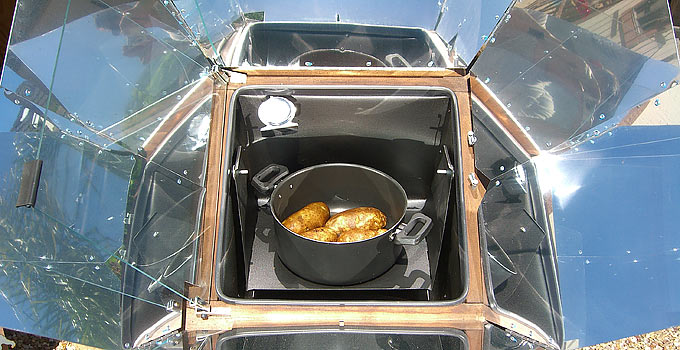
Use it as a Slow Cooker / Crock-Pot
Since solar cookers generally cook slower than a conventional oven, a long slow cook at say about 225 – 275, combined with a bit of added water in the pot for the food to draw in, will turn out scrumptious!
The food won’t burn (it generally doesn’t get hot enough to burn) and won’t overcook. The SUN OVEN is well insulated and cooks very evenly.
In the past, we’ve loaded it up in the morning, set the position for mid-day sun, and left it till dinner time. Yum! Of course you need to be assured of a sunny day with not too much wind.
“Don’t be afraid to experiment. It’s almost impossible to burn food in a SUN OVEN. Food doesn’t dry out, so it’s very difficult to screw anything up. When in doubt, cook longer.” said the manufacturer.
What about cooking on a cloudy day?
Well, my experience is that no solar oven will work well during a cloudy overcast day. And most won’t even work reliably during partly cloudy days (depending). However, unlike other solar ovens which require full sunlight, the All American Sun Oven works incredibly well, even on partly cloudy days.
It’s thick glass and well-designed seal gasket keeps the heat in (as well as the insulation).
Wind!
Too much wind will affect pretty much any solar oven with protruding reflector panels. The solar reflector panels will certainly be affected by winds above a certain threshold. You don’t want it knocked over, and/or damage to the reflector panels. So if it’s going to be too windy, well, don’t set it up.
Here’s a tip. If you know the prevailing wind direction that day, you could set up your solar oven on the opposite side of the house somewhere, or anywhere else where there may be enough protection from the wind. However obviously this depends on the view of the sky from those alternate locations.
Keeping the All American Sun Oven optimized by tracking earth’s rotation
This is only important if you’re cooking a long slow cooked meal.
For long cooked meals, to maintain a high enough temperature may require that you rotate the solar cooker a few times during the cooking process to keep facing the sun.
During the summer months when the sun is high in the sky, rotating the solar cooker repeatedly to face the sun is generally not required (unless you’re really trying to optimize temperatures).
During the Spring, Fall, and Winter when the sun is lower in the sky, you will probably need to keep up with it.
One problem during months when the sun is low in the sky is that more obstacles will get in the way and shade an area. So, unless you have a fairly wide open space, surrounding trees will become an issue.
A Few More Examples Using Our SUN OVEN
We also used our All American Sun Oven to slow cook beans throughout the day.
[ Read: How To Cook Dried Beans With A Solar Oven ]
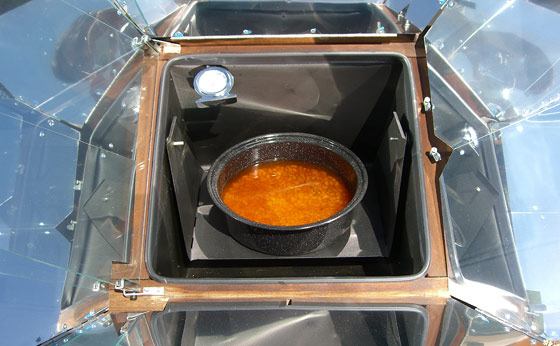
Bake your own homemade bread too!
[ Read: What Happened One Time That I Made Solar Oven Bread ]

Cooking Sweet Potatoes in the Solar Cooker:
